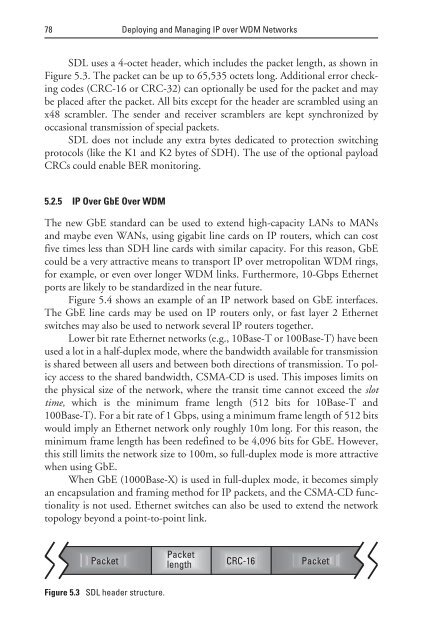deploying and managing ip over wdm networks - Index of
deploying and managing ip over wdm networks - Index of
deploying and managing ip over wdm networks - Index of
Create successful ePaper yourself
Turn your PDF publications into a flip-book with our unique Google optimized e-Paper software.
78 Deploying <strong>and</strong> Managing IP <strong>over</strong> WDM Networks<br />
SDL uses a 4-octet header, which includes the packet length, as shown in<br />
Figure 5.3. The packet can be up to 65,535 octets long. Additional error checking<br />
codes (CRC-16 or CRC-32) can optionally be used for the packet <strong>and</strong> may<br />
be placed after the packet. All bits except for the header are scrambled using an<br />
x48 scrambler. The sender <strong>and</strong> receiver scramblers are kept synchronized by<br />
occasional transmission <strong>of</strong> special packets.<br />
SDL does not include any extra bytes dedicated to protection switching<br />
protocols (like the K1 <strong>and</strong> K2 bytes <strong>of</strong> SDH). The use <strong>of</strong> the optional payload<br />
CRCs could enable BER monitoring.<br />
5.2.5 IP Over GbE Over WDM<br />
The new GbE st<strong>and</strong>ard can be used to extend high-capacity LANs to MANs<br />
<strong>and</strong> maybe even WANs, using gigabit line cards on IP routers, which can cost<br />
five times less than SDH line cards with similar capacity. For this reason, GbE<br />
could be a very attractive means to transport IP <strong>over</strong> metropolitan WDM rings,<br />
for example, or even <strong>over</strong> longer WDM links. Furthermore, 10-Gbps Ethernet<br />
ports are likely to be st<strong>and</strong>ardized in the near future.<br />
Figure 5.4 shows an example <strong>of</strong> an IP network based on GbE interfaces.<br />
The GbE line cards may be used on IP routers only, or fast layer 2 Ethernet<br />
switches may also be used to network several IP routers together.<br />
Lower bit rate Ethernet <strong>networks</strong> (e.g., 10Base-T or 100Base-T) have been<br />
used a lot in a half-duplex mode, where the b<strong>and</strong>width available for transmission<br />
is shared between all users <strong>and</strong> between both directions <strong>of</strong> transmission. To policy<br />
access to the shared b<strong>and</strong>width, CSMA-CD is used. This imposes limits on<br />
the physical size <strong>of</strong> the network, where the transit time cannot exceed the slot<br />
time, which is the minimum frame length (512 bits for 10Base-T <strong>and</strong><br />
100Base-T). For a bit rate <strong>of</strong> 1 Gbps, using a minimum frame length <strong>of</strong> 512 bits<br />
would imply an Ethernet network only roughly 10m long. For this reason, the<br />
minimum frame length has been redefined to be 4,096 bits for GbE. However,<br />
this still limits the network size to 100m, so full-duplex mode is more attractive<br />
when using GbE.<br />
When GbE (1000Base-X) is used in full-duplex mode, it becomes simply<br />
an encapsulation <strong>and</strong> framing method for IP packets, <strong>and</strong> the CSMA-CD functionality<br />
is not used. Ethernet switches can also be used to extend the network<br />
topology beyond a point-to-point link.<br />
Packet<br />
Figure 5.3 SDL header structure.<br />
Packet<br />
length CRC-16 Packet


